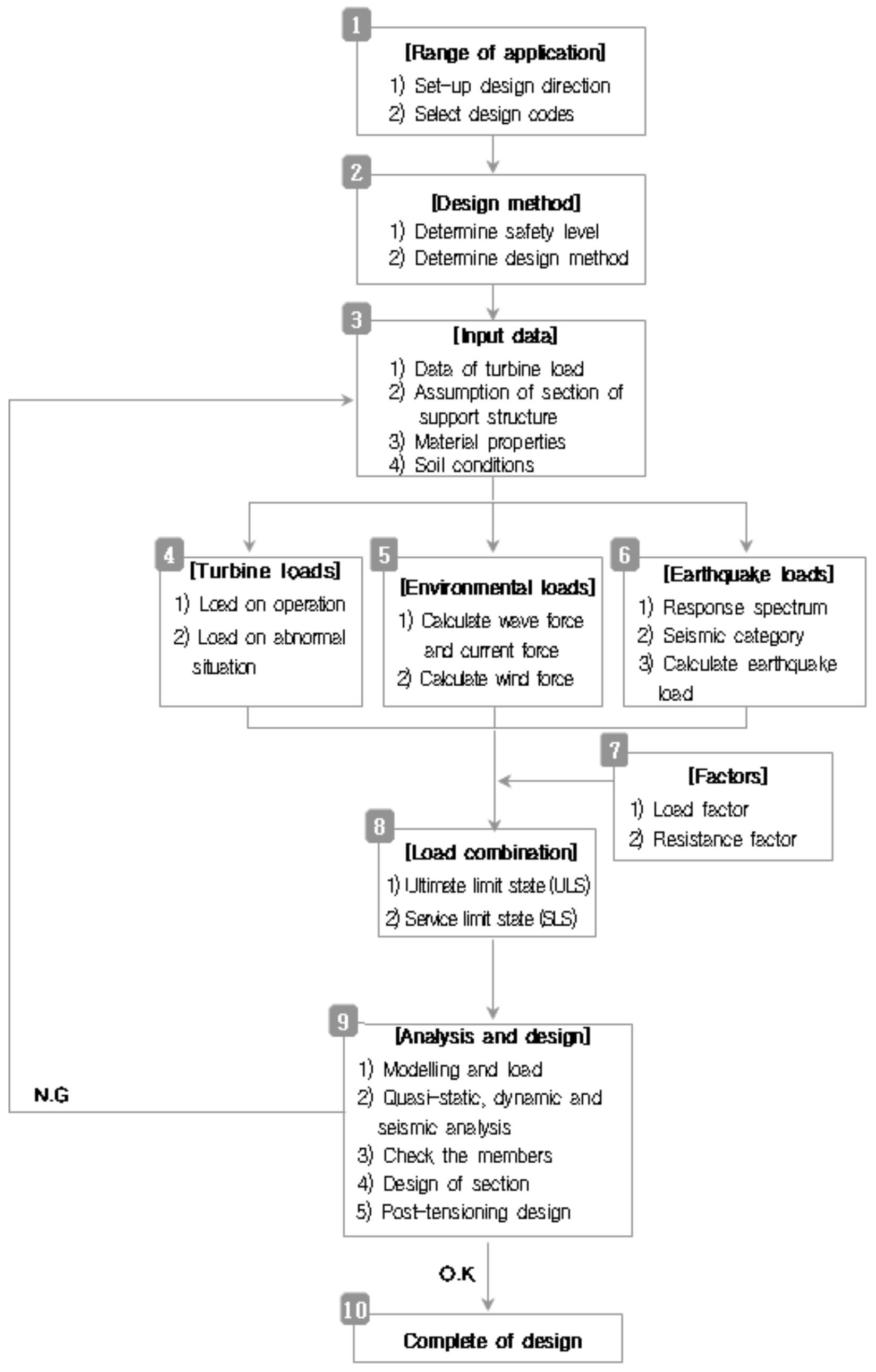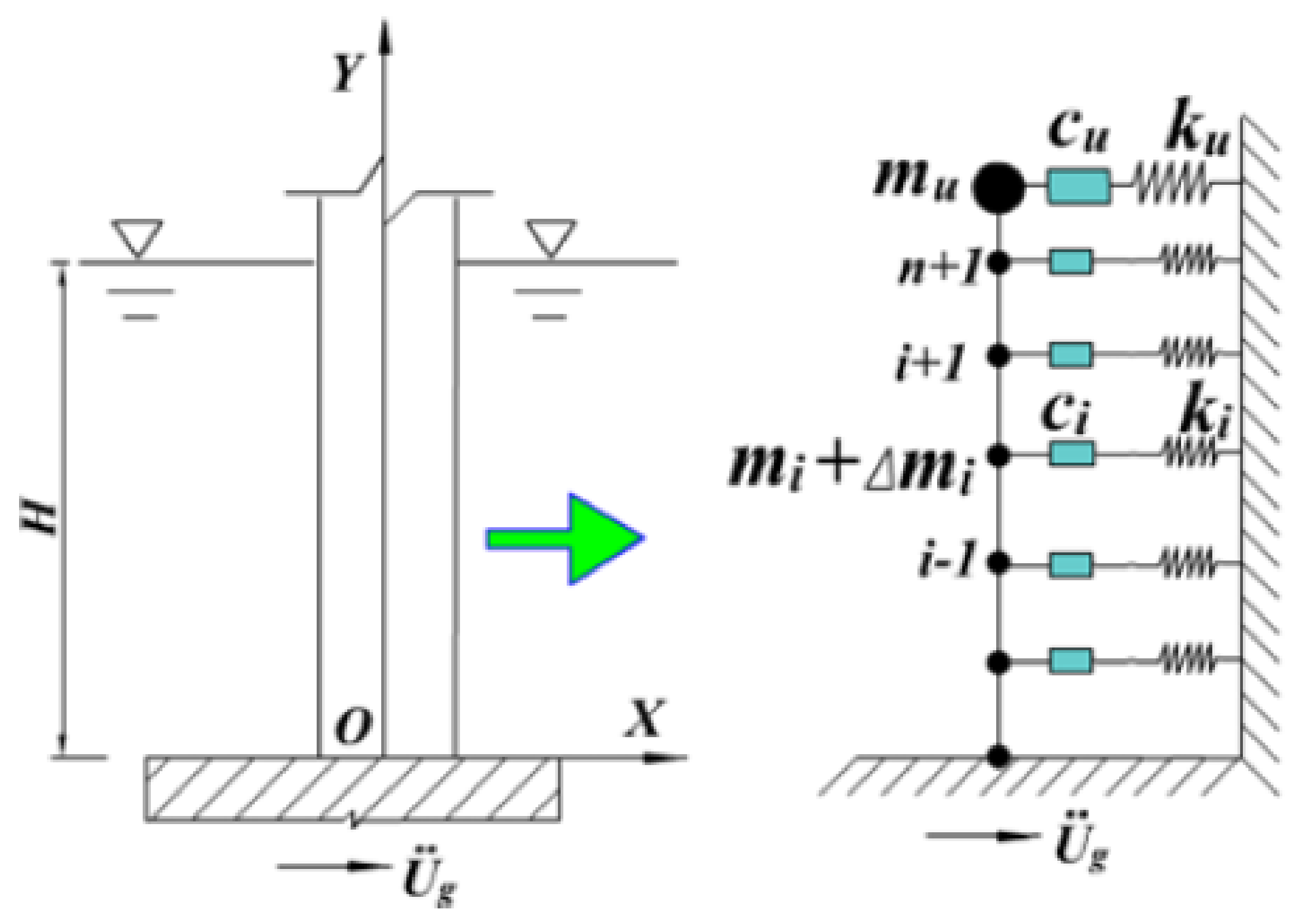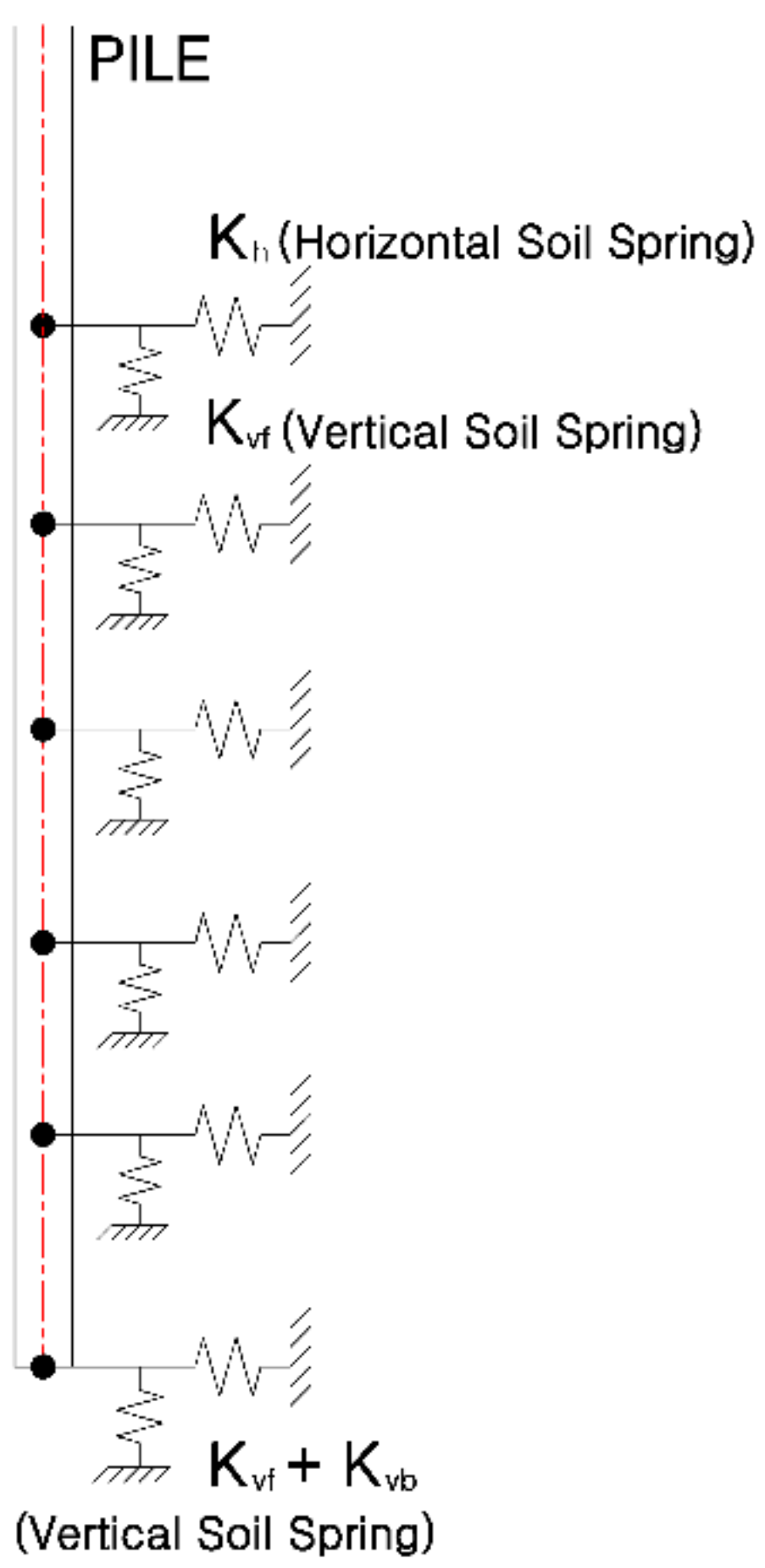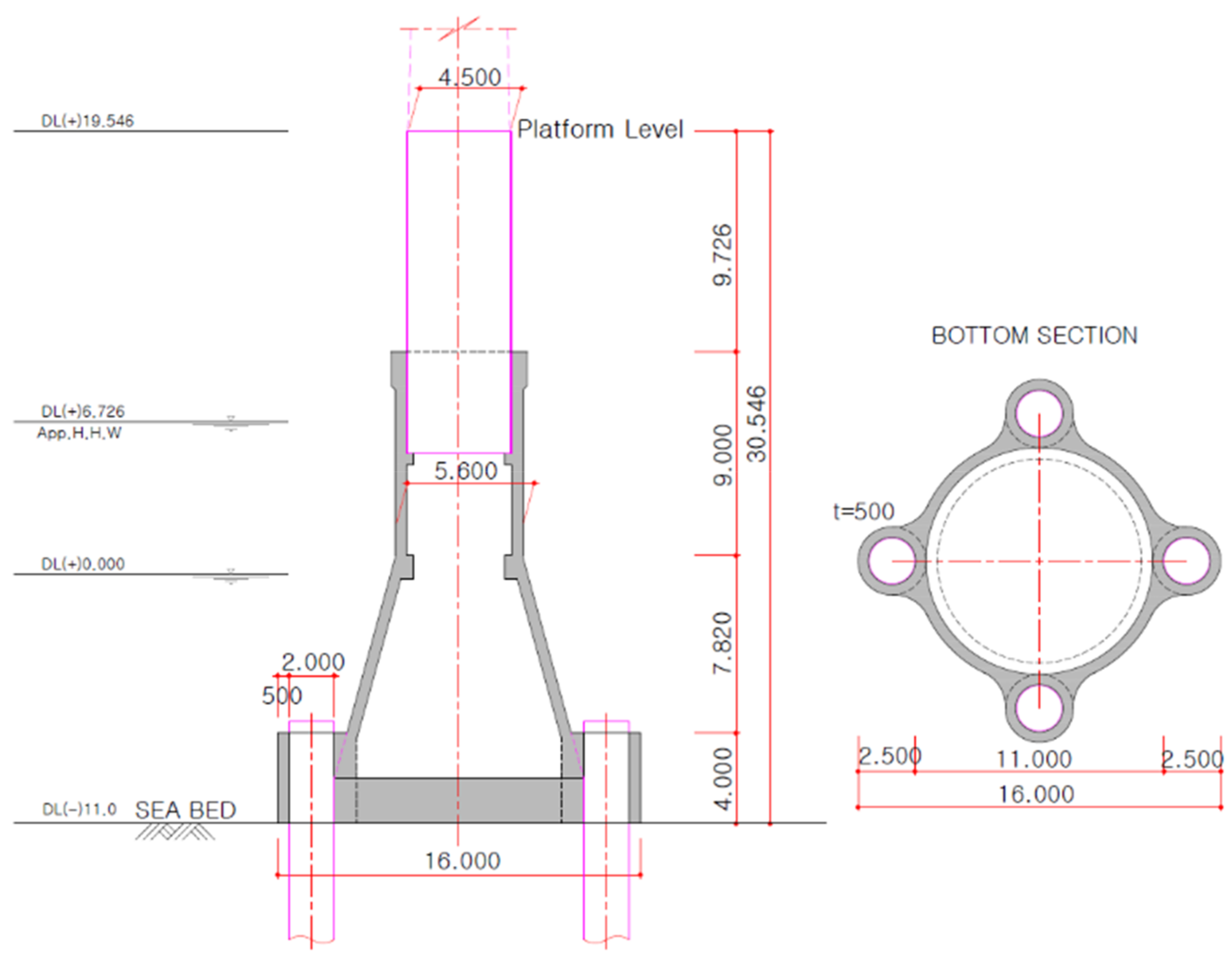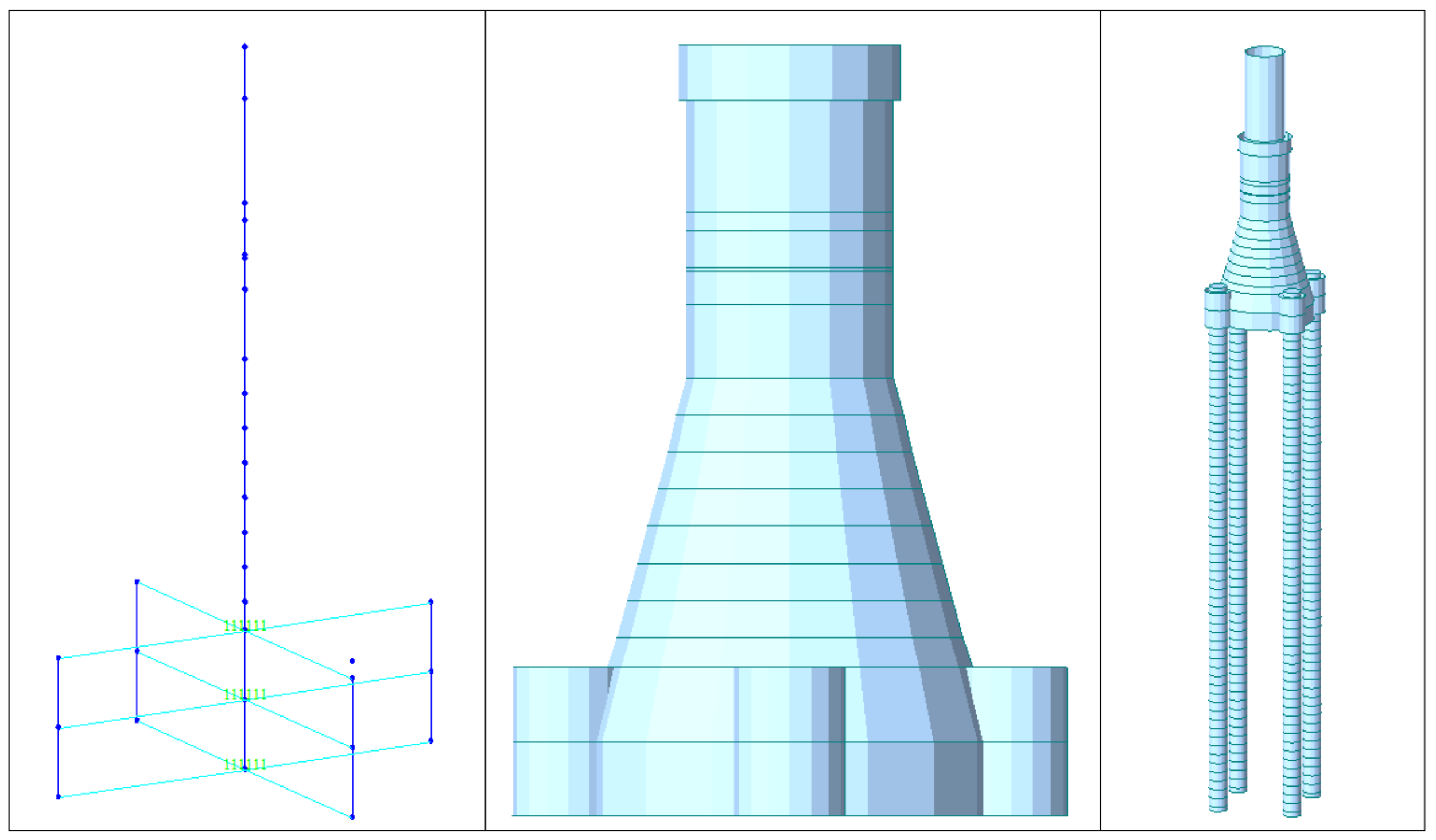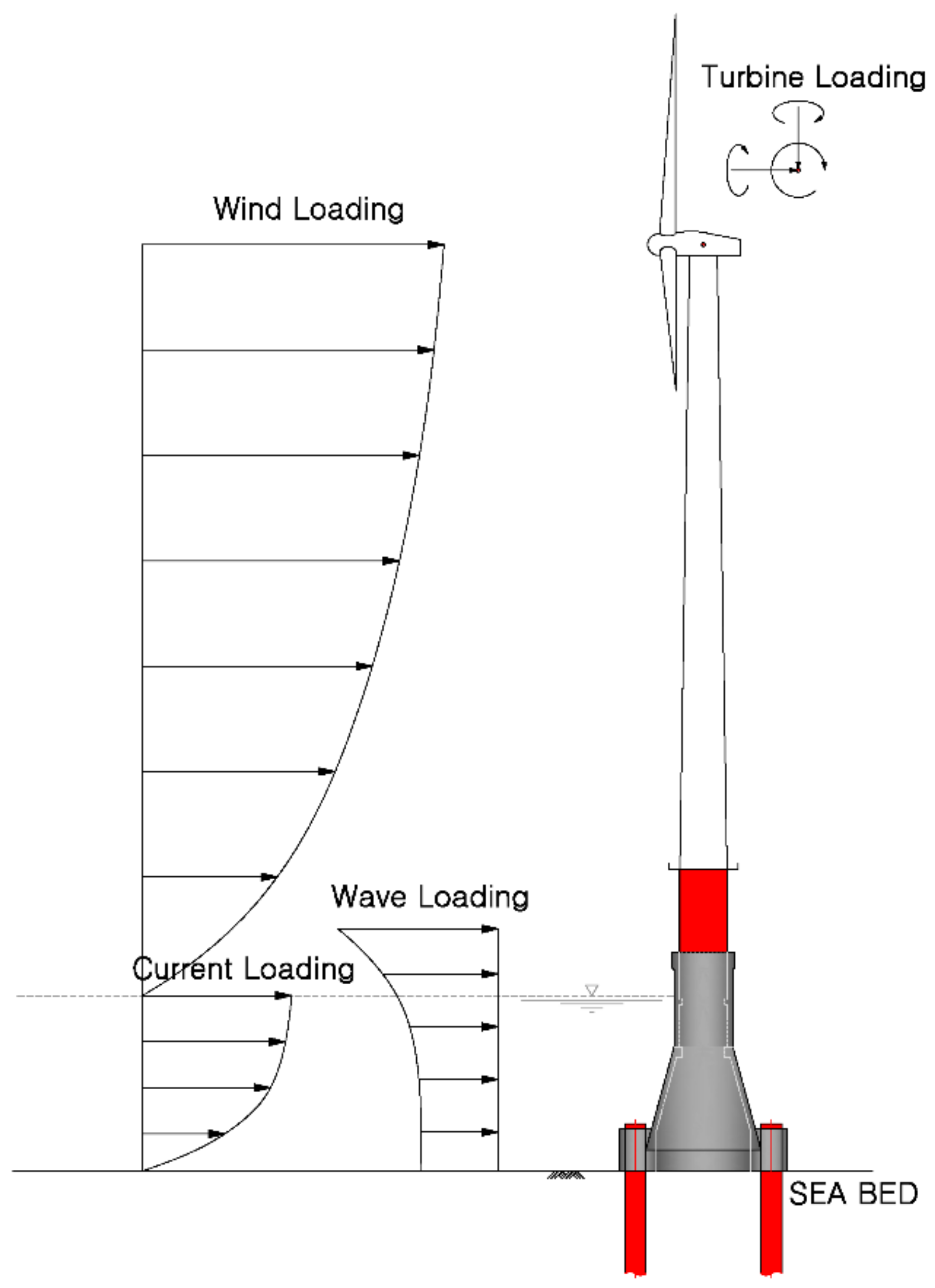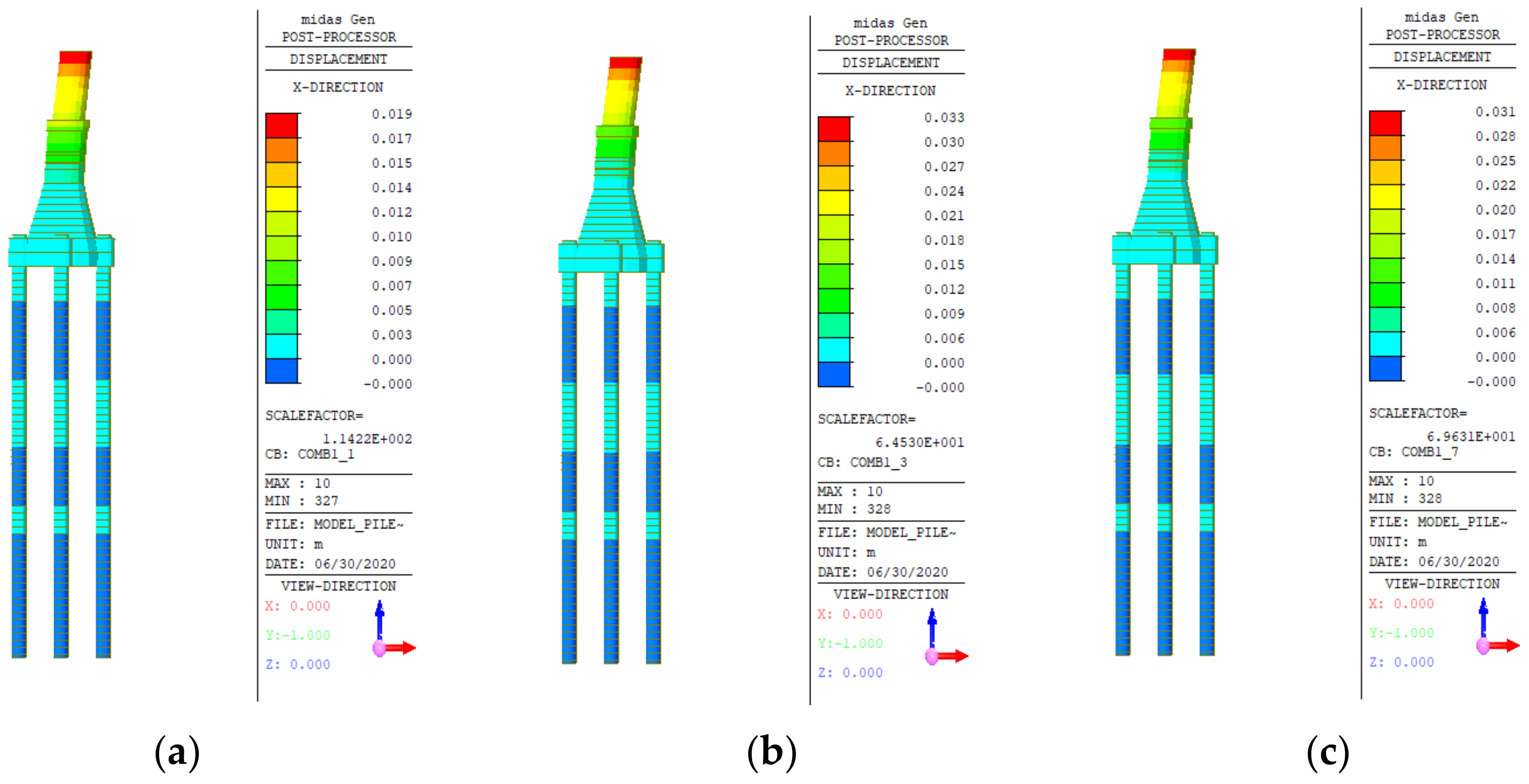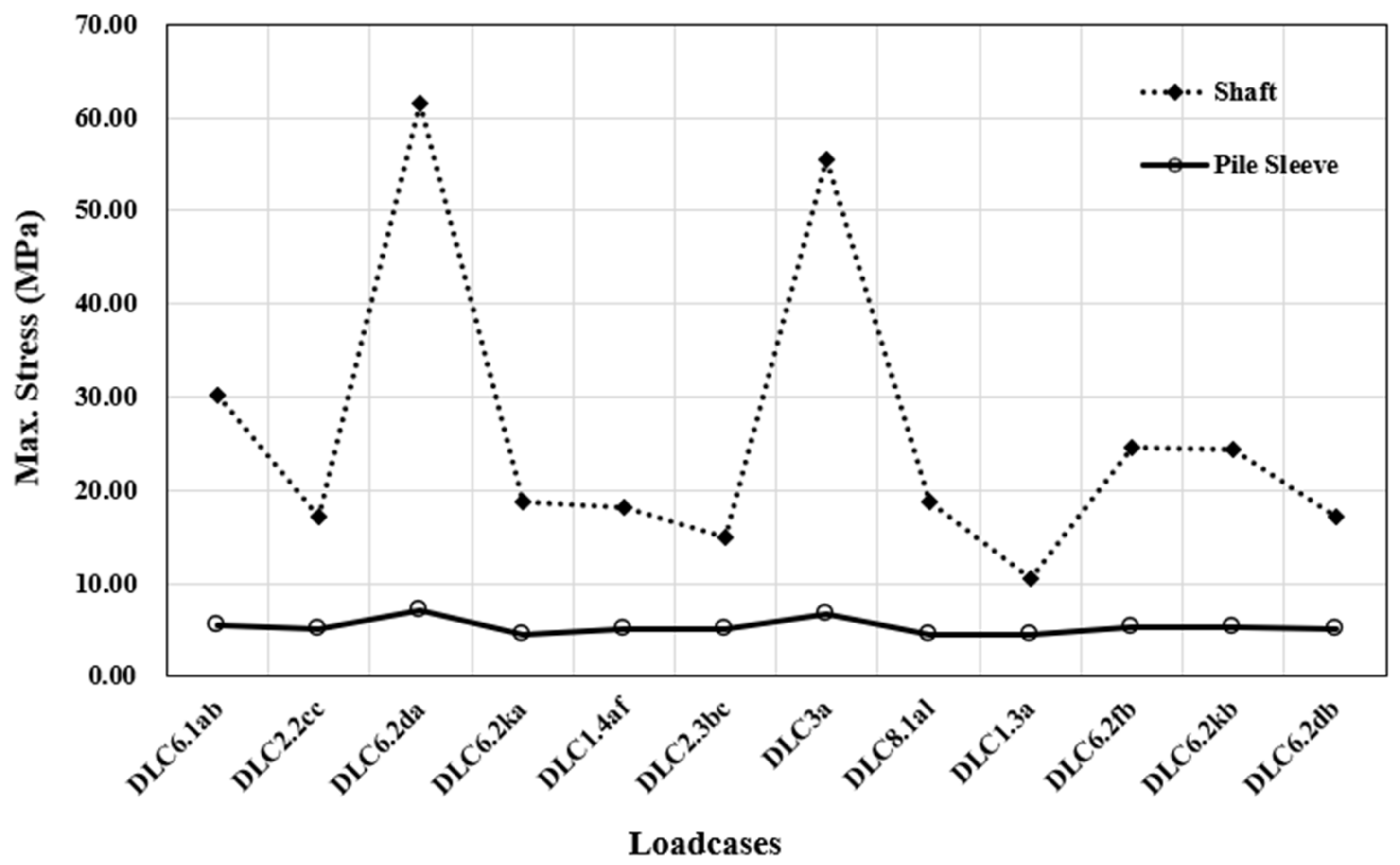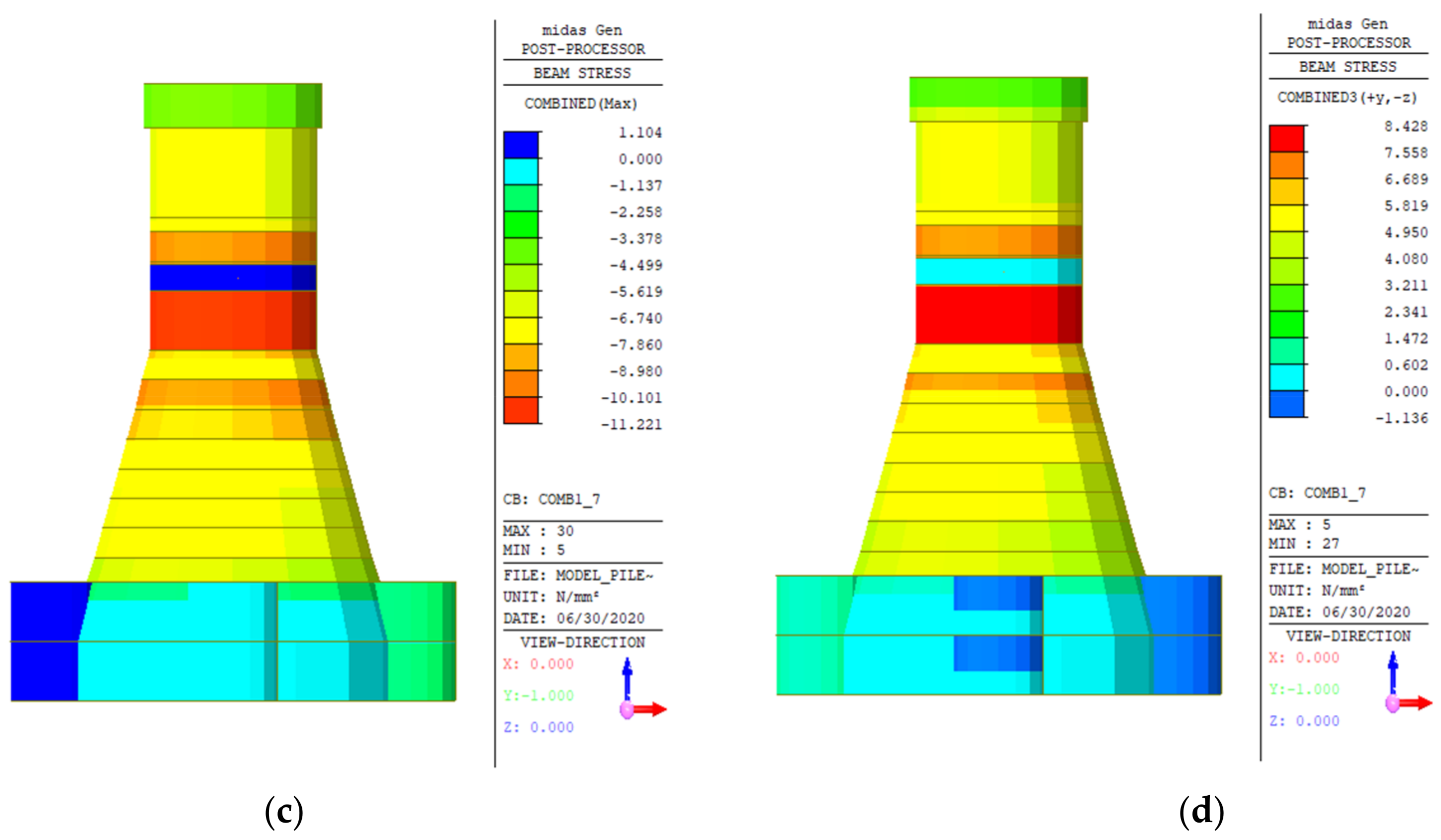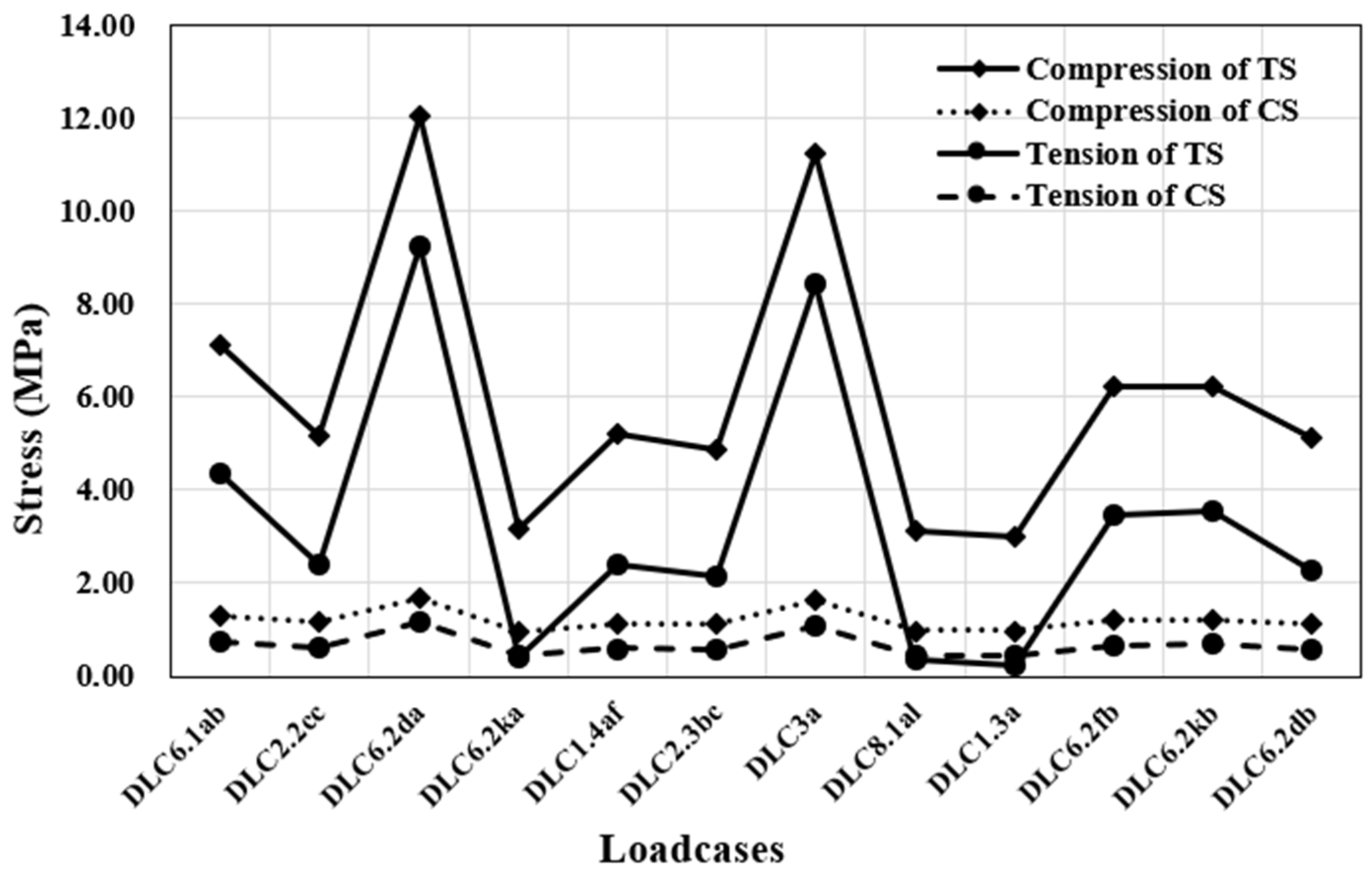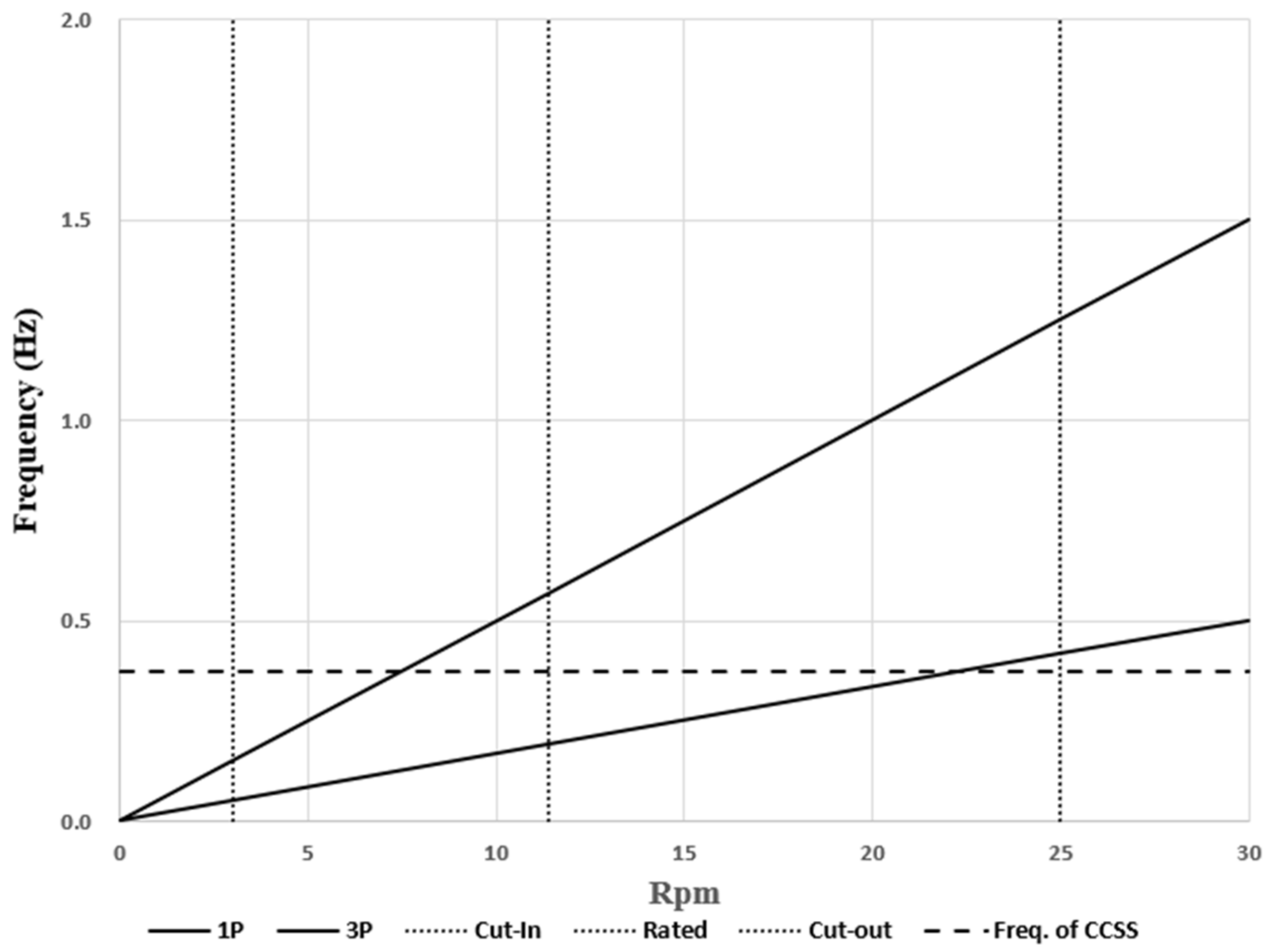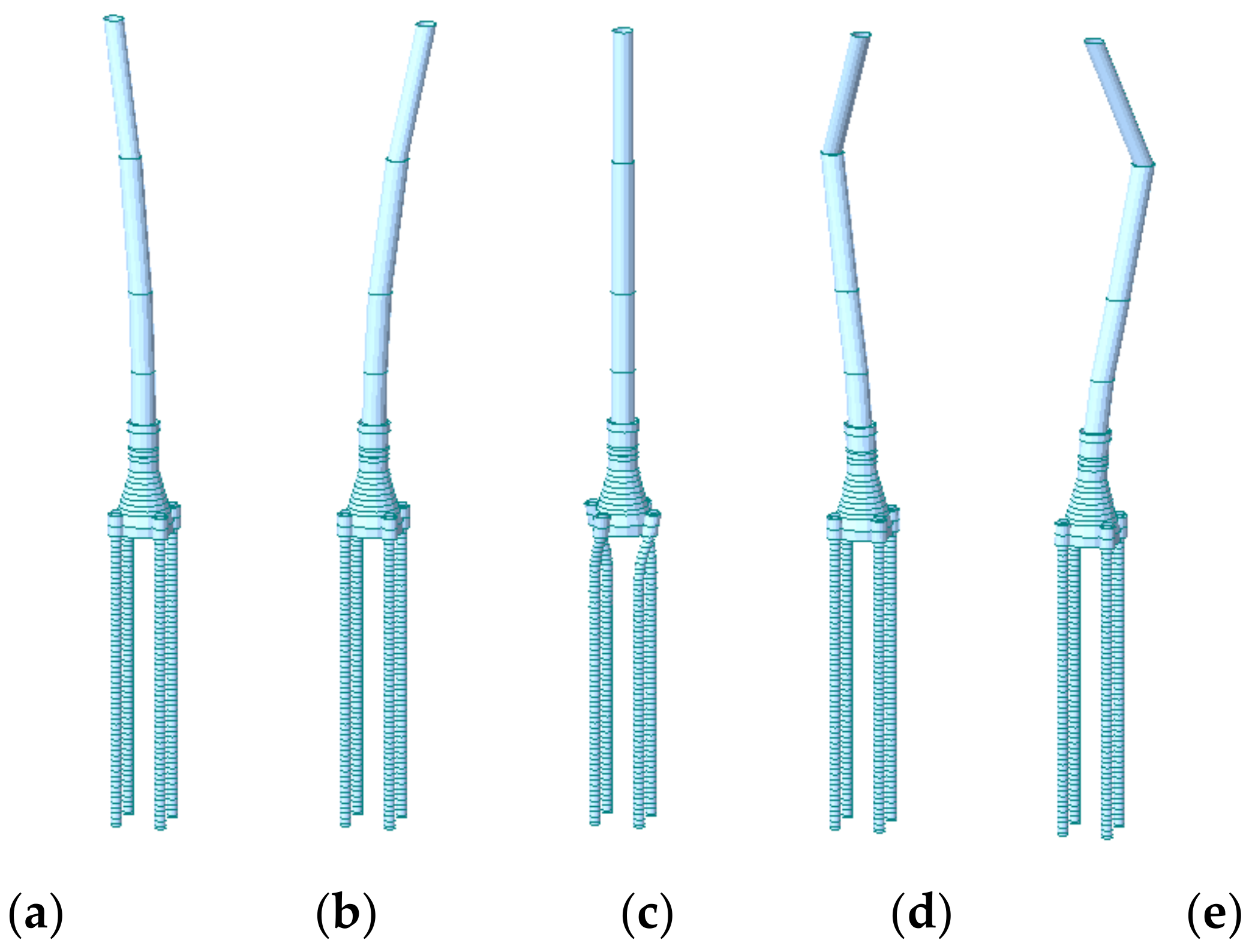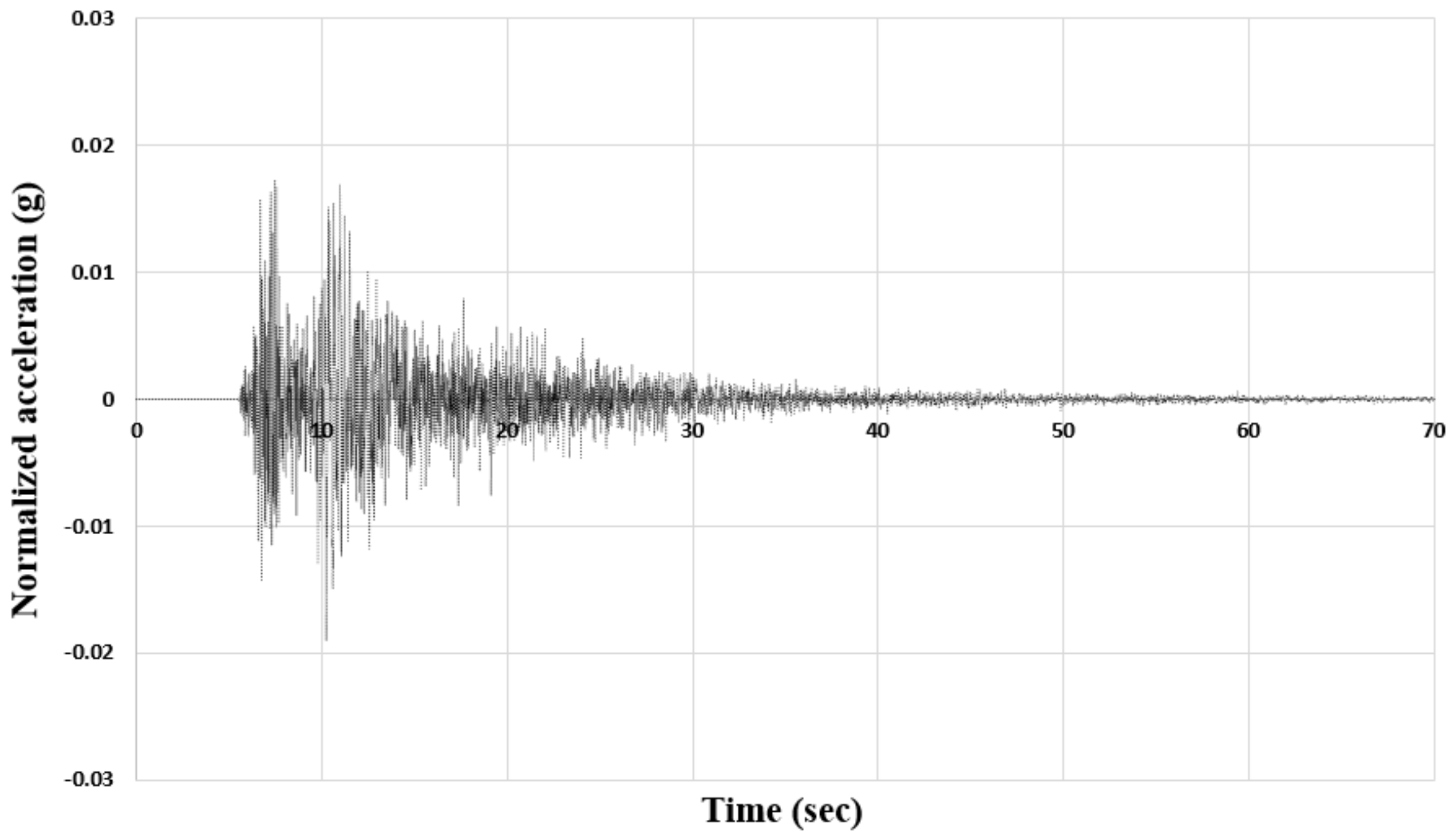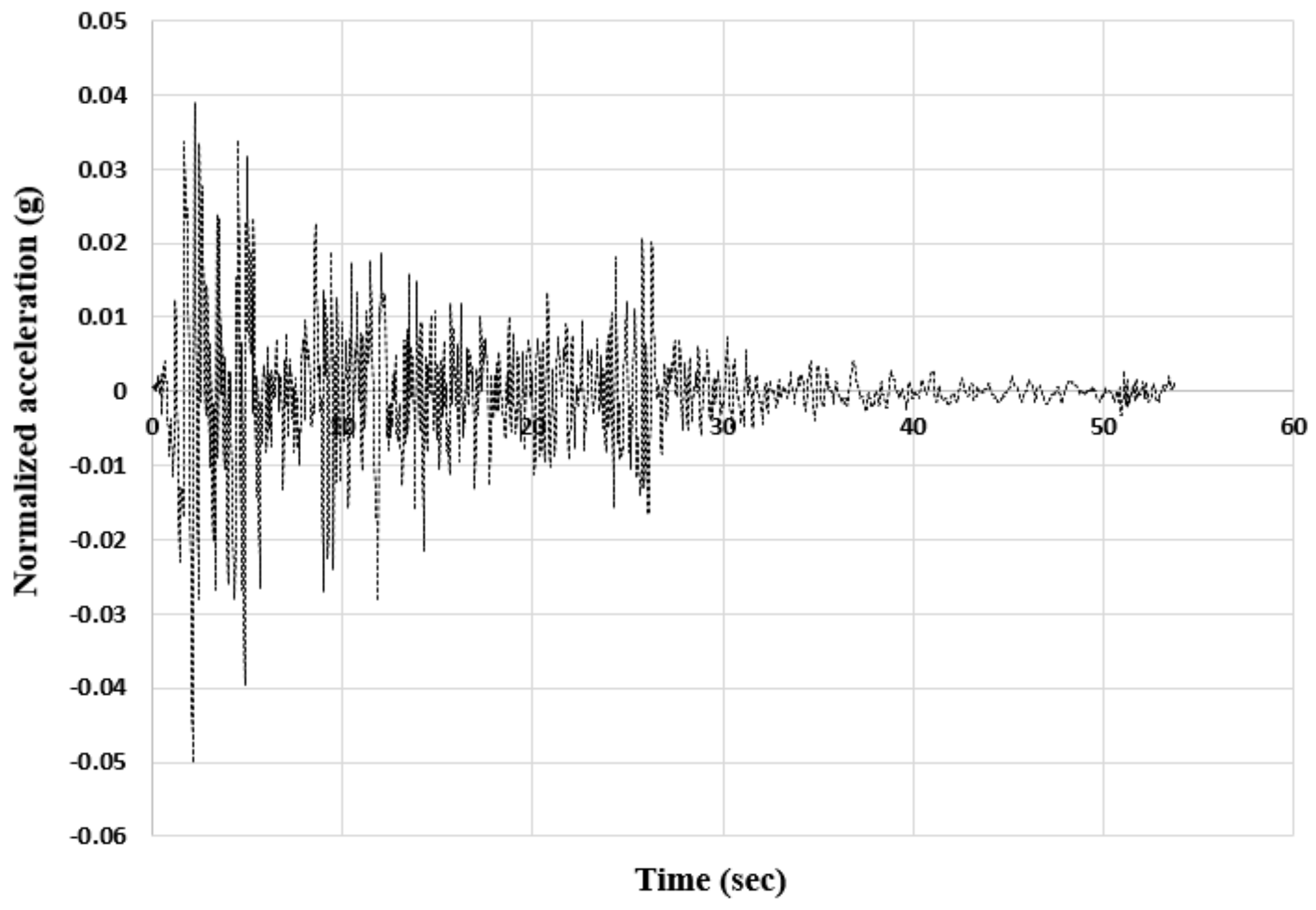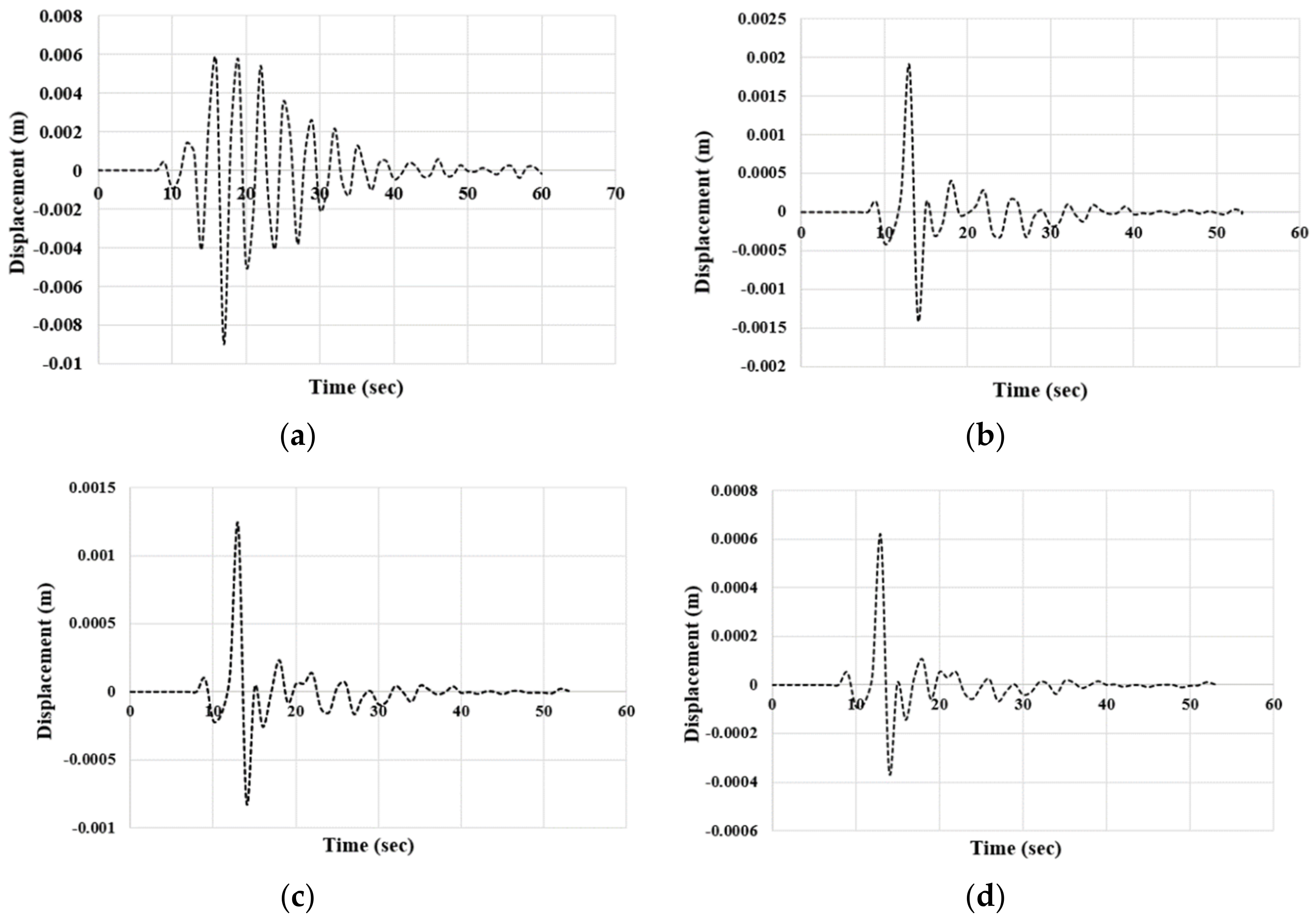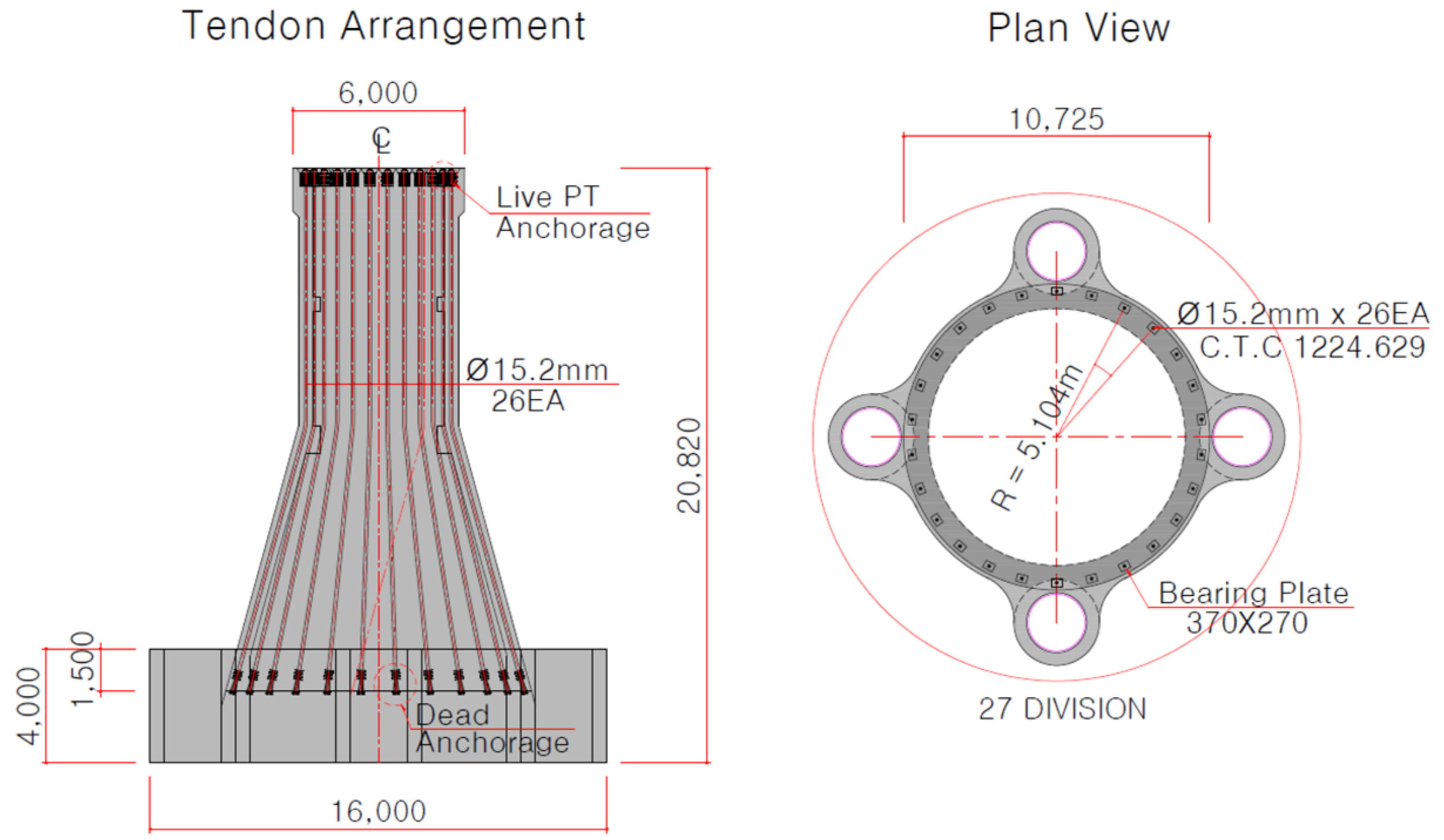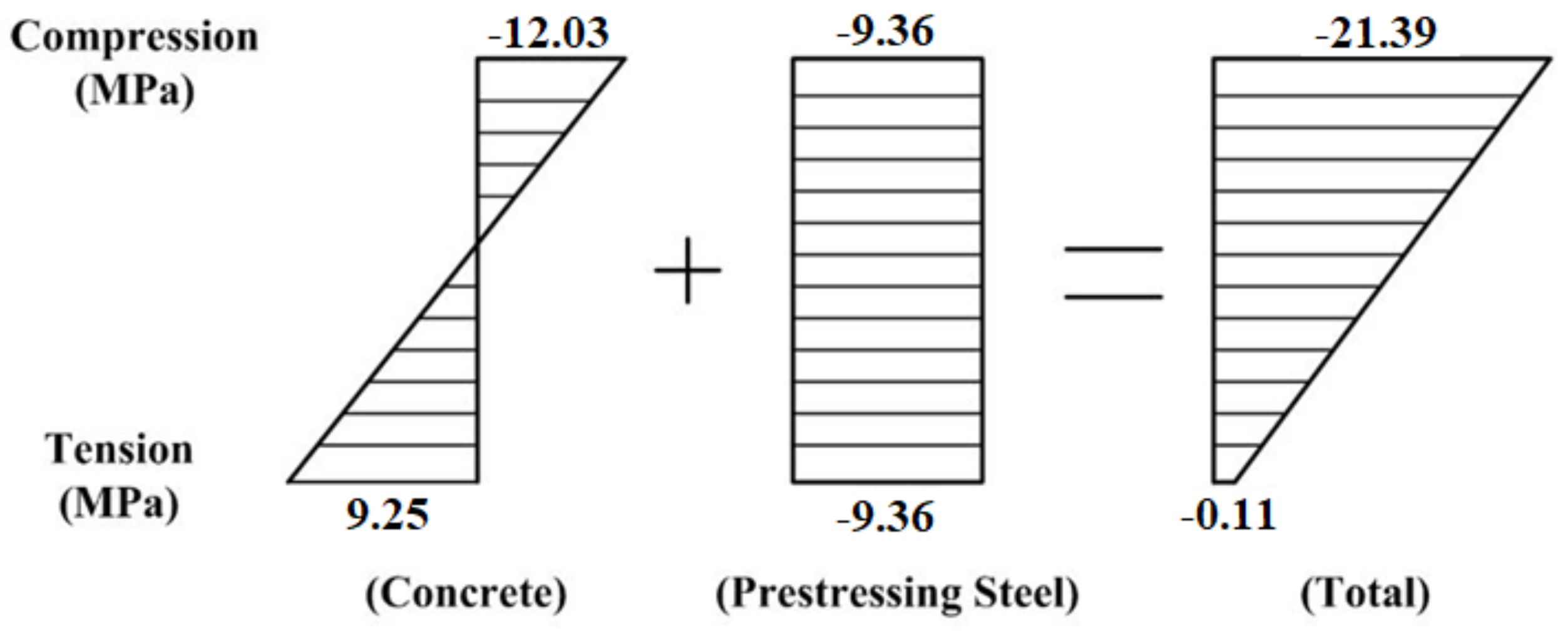1. Introduction
Many fixed types of support structures for offshore wind turbines have been developed. Steel monopiles and jackets are most commonly used due to their advantages associated with manufacturing and installation, but they also have several problems, such as corrosion and high costs. To overcome these problems, concrete has been used in support structures. Concrete has many advantages, such as high erosion resistance, high stiffness, good damping properties, a short installation time, and a long service life. Cost is a critical consideration when selecting the type of support structure for a given site. Concrete is more cost-efficient than steel because it has a low material cost. Referring to tender results of two projects named Middelgrunden and Nysted [
1], market response in both cases very clearly showed that a concrete solution could be manufactured and installed at a lower price.
Due to the advantages of concrete, many studies have focused on concrete support structures. The first concrete gravity-based structure (GBS), called Condeep B, was built in Stavanger, Norway, in 1975 [
2]. GBS was designed for the great water depths and extreme weather conditions in the North Sea. Since 1991, eleven GBSs for 5-MW offshore wind farms have been installed off the coast of Lolland, Denmark [
3]. In 2009, GBSs for 5-MW offshore wind turbines were constructed in water depths of 27.5 m at Thornton Bank 1 along the coast of Vlaanderen, Belgium [
4], and GBSs for 2.3-MW offshore wind turbines were installed by COWI at Red Sand 2, Denmark, where the maximum water depth is 15.0 m [
5]. Currently, conceptual GBS structures for deep water areas are being studied in Europe. Vici Ventus developed a massive concrete GBS for use in water depths of 30–100 m [
6]. The construction of the structure was not complicated because it uses concrete from the tower base to bottom, and this GBS was designed to use either a gravity base or a skirt pile. Esteban identified the processes and methods used in installations of the most relevant types of GBSs in the offshore wind facilities operating in Europe [
7]. In 2016, Yan et al. developed novel gravity based arctic offshore structure [
8]. This is a steel–concrete–steel sandwich system to resist ice loads and low temperature. Yuzhu et al. numerically analzed wave-induced poro-elastic seabed response around a hexagonal gravity-based offshore foundation [
9]. The effect of isotropic and anisotropic soil permeability on the pore pressure distribution was investigated and 3D numerical analysis is performed to investigate the wave-induced soil response and liquefaction risk around a hexagonal gravity-based offshore foundation. Zhao et al. implemented stochastic dynamic analysis of an offshore wind turbine concrete suction bucket foundation by the path integration method [
10]. The structure is simplified as a linear single-degree-of-freedom system and path integration method is applied to calculate joint probability density function of dynamic responses.
However, concrete GBSs are difficult to construct on the weak soil along the coast because the GBS must withstand the horizontal loads caused by its own weight. To overcome this problem, hybrid types of foundations consisting of concrete and steel have been investigated. In 2013, Kim suggested a hybrid type of foundation composed of a concrete tripod and a steel shaft and performed a preliminary analysis and design [
11]. Kim suggested a new hybrid concrete support structure that is supported not only by a gravity-type foundation but also by driven piles, and this design reduces the weight of the structure [
12]. In 2018, Kim et al. carried out a feasibility study of a hybrid pile-concrete foundation for a 5-MW offshore wind turbine by performing a quasi-static analysis and seismic analysis with 3D solid elements [
13].
Park et al. proposed a hybrid substructure with multiple cylinders to reduce the hydrodynamic effects in the shortwave region [
14]. The cylinders have different radii in the upper and lower areas, which leads to decreased wave forces.
Abdelkader suggested a hybrid structure involving a hollow steel pile connected to a precast concrete cap [
15]. The structure includes monopiles with diameters of 4 and 6 m and a hybrid system with a pile diameter of 4 m attached to a concrete plate with and without ribs, and the plate diameter is 12 or 16 m. In 2016, Lee et al. studied a hybrid substructure with a concrete base-to-sleeve connection [
16]. This hybrid substructure has a concrete base, multiple concrete piles, and a tower connection member, and a composite section is used to reduce the weight of the structure.
The hydrodynamic pressure and water-added mass affect the dynamic behavior of a structure in water, and it is essential to consider the fluid–soil–structure interaction (FSI) to accurately evaluate the performance of the structure. Numerous studies have focused on FSI, and different approaches have been presented. Fish et al. studied FSI using Morison’s equation and proposed a simplified method to calculate the wave forces [
17]. Tao et al. considered the additional mass of moving structures in water using Morison’s equation and considered the fluid effects [
18]. The added mass method of Liaw et al. is commonly used to consider the effects of the surrounding water [
19]. Yang et al. proposed a new added mass calculation method called the added mass ratio method (AMRM) to reduce the errors in the simple added mass method of Liaw [
20].
Although many studies have investigated the FSI of monopiles or jacket structures, few studies have considered the FSI of concrete structures. Due to the heavy weight and large projected area of the fluid, an analysis model for a concrete structure that considers FSI is needed. Lim et al. implemented FSI analysis of GBS offshore platform with partitioned coupling method [
21]. This approach is to utilize the advantage of the existing numerical algorithms in solving the complex fluid and structural interactions. A previous study examined the feasibility of a 5-MW-class concrete foundation structure [
13]. For the structural analysis, 3D solid elements were used, and the tendon was included in the model. The results confirm that the tensile stress generated in the concrete foundation structure can be effectively controlled by introducing prestressing in advance by applying wire strands. However, in this study, the analysis of the CCSS was performed without applying prestressing, and the design was implemented by applying strand wire to reduce the tensile stress. In 2020, Kim et al. presented an efficient analysis method of a piled concrete foundation considering FSI [
22]. Three analytical parameters, the type of pile, boundary conditions, and location of stress concentration, were considered for analysis models, and it showed that consideration of piled foundation has a reasonable result and influences the natural frequency.
The existing GBS is known to be applied to shallow water depth since the deeper the water depth, the greater the diameter of structure, and this leads to increase the manufacturing cost. However, hybrid type of CCSS can be applied to deep water as it serves to connect the pile foundation and the tower by extending the upper shaft while keeping the cross section of the support structure. In addition, the trend of offshore turbines is large-capacity turbines of 15 MW [
23,
24], and, to secure economic efficiency according to the increase in turbine capacity, concrete materials that are advantageous in terms of cost need to be used. Thus, CCSS is a support structure that can secure economical advantage and can be applied to large-capacity turbines and deep water.
The objectives of this paper are to establish a structural analysis model of a concrete support structure for an offshore wind turbine and to optimize the design of a conical concrete support structure (CCSS) for a 3-MW-class offshore wind turbine. A CCSS is a hybrid type of concrete foundation with a conical shape and driven piles that uses steel and concrete unlike gravity-type foundations. This support structure consists of a concrete base, a steel shaft, and steel piles. The marine conditions of Phase 1 test site of southwest offshore wind project in Korea are considered, and FSI is analyzed with the added mass method and a soil spring model to consider the effects of the surrounding water and soil. A quasi-static analysis was carried out to design the CCSS, and a natural frequency analysis with an added mass was performed to investigate the dynamic behavior of the CCSS. Moreover, to evaluate the seismic behavior of the CCSS, response spectrum and time-history analyses were performed.
5. Conclusions
This paper presents an analysis model and design optimization for a CCSS. A structural analysis model of the CCSS that considered FSI was established from the dynamic analysis. The design optimization was performed based on a flow chart of the design process for prestressed concrete foundations.
The marine conditions of Phase 1 test site of southwest offshore wind project in Korea and a 3-MW-class offshore wind turbine were considered, and FSI was applied using the added mass method and a soil spring model to take into account for the effects of the surrounding water and soil.
The quasi-static analysis showed that the CCSS has sufficient rigidity because the maximum displacements are smaller than the allowable values. The results of the natural frequency analysis revealed the importance of dynamic structural stability, with particular attention being given to the resonance. The natural frequency of the CCSS was in a safe range to avoid a resonance, indicating that the CCSS has superior dynamic behavior. Through a response spectrum analysis and time-history analysis, the CCSS was found to be sufficiently safe under the applied earthquake loads.
To reduce the tensile stress in the CCSS, which exceeded the allowable stress, a post-tensioning design was implemented by applying prestressing steel. The results confirm that the CCSS with the optimized section can attain structural stability through the prestressed concrete design.
Consequently, the results show that the CCSS is sufficiently safe under the extreme loads of the marine conditions along the southwest coast of Korea. The methods and conclusions of this study provide a theoretical reference for the structural analysis and design of concrete support structures for offshore wind turbines.
